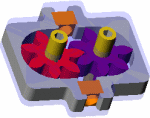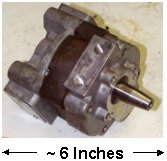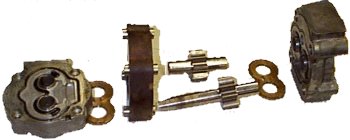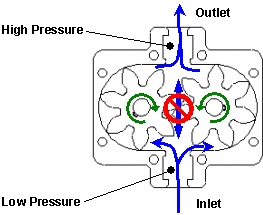 |
GEAR PUMPS |
 |
| TITLE: | How Gear Pumps Work |
| AUTHOR: | Martin L. Culpepper |
| COURSE: | 2 |
| YEAR: | G |
| MAIN FUNCTIONAL REQUIREMENT: | DESIGN PARAMETER: |
| Convert mechanical power into fluid power. | Pump (a gear pump is one type of pump which can satisfy this functional requirement) |
EXPLANATIONS OF GEOMETRY AND PARTS
| GEAR PUMP FROM CONSTRUCTION TRUCK | EXPLODED VIEW OF COMPONENTS |
 |
 |
HOW IT WORKS:
| ANIMATION OF GEAR PUMP | FLOW OF FLUID THRU GEAR PUMP |
 |
 |
One shaft is driven by a motor or some other means
The gear mounted to this shaft (driving gear) engauges the other gear (driven gear)
Fluid on the inlet side flows into and is trapped between the rotating gear teeth and the housing
The fluid is carried around the outside of the gears to the outlet side of the pump
As the fluid can not seep back along the path it came nor between the engauged gear teeth (they create a seal,) it must exit the outlet port.
DOMINANT PHYSICS:
| Nomenclature | |||
| Variable | Description | Metric Units | English Units |
| Pin | Power input to shaft | Watts | Horsepower |
| Pout | Power output to fluid system | Watts | Horsepower |
| Ploss | Power loss (i.e. to coloumb friction and viscous dissapation) | Watts | Horsepower |
| w | Shaft rotational speed | rad/s | RPM |
| Dp | Pressure increase between inlet and outlet | Pascals | psi |
| Q | Flow rate through the pump | liters3/s | in3/s |
| hm | Mechanical efficiency | --- | --- |
The pump takes power from a rotating shaft:
Pin = T x w
Some of this power is dissapated in the pump through coloumb friction and viscous disappation. This is not easily quantified theoretically and is often determined experimentally. This power will be denoted at Ploss.
Ploss = f(friction, viscous effects......)
In addition some fluid will seep through the gap between the sides of the gears and the endplates. This gap must be small in order to maintain the pressure increase across the pump. Increasing the gap diminishes the pumps ability to hold a pressure difference between the inlet and outlet. The gap is typically around 0.0005 inches.
The power which can then be derived from the fluid which comes out of the pump is:
Pout = (Dp x Q) = Pin - Ploss = T x w - Ploss
This can also be expressed using the efficiency:
Pout = hm x Pin
LIMITING PHYSICS
The performance/use of the pump is limited by its:
Efficiency
hm=of a pump is Pout/Pin. This is a function of the fluid viscocity, clearance between internal components, friction between mating components, and other variables.
Typically, gear pumps have efficiencies around 85%.
Bearings
Many external gear pumps use journal bearings to support the rotating shafts. In order for these bearings to work, a minimum speed is required (depends upon pressure of the pump)
Should the pressure difference across the pump be too large, the net force on the shafts will exceed the load the journal bearings can sustain. This is why pumps are rated for maximum press
minimum speed
maximum pressure
HELPFUL PLOTS/GRAPHS/TABLES:
WHERE YOU CAN FIND GEAR PUMPS:
These pumps have few moving parts, making them inexpensive. These pumps are typically used where low to medium pressure (about 2500 - 4000 psi) is needed and mechanical efficiency is not extremely important (typical efficiency is about 85%.)
You can find gear pumps on the following machines:
- Usually your cars oil pump
- Hydraulically driven lawn care equipment
- Some hydrayulically driven log splitters
- Hydraulic power units on trucks and construction equipment
- Metering applications (gear pumps are good at controlling volume flow rate)